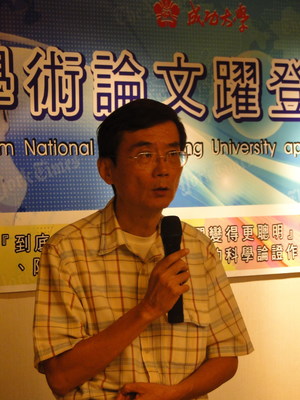National Cheng Kung University Research Paper appearing on The New York Times



Tainan, TAIWAN, Oct. 1st --- Prof. Chauying J. Jen (任卓穎) and Prof. Hsiun-Ing Chen (陳洵瑛) from Department of Physiology of College of Medicine, National Cheng Kung University (NCKU), Taiwan, published the research paper, entitled “Differential effects of treadmill running and wheel running on spatial or aversive learning and memory: roles of amygdalar brain-derived neurotrophic factor and synaptotagmin I”, on the Journal of Physiology in this May. Their scientific discovery was recently cited and reported in the column of the New York Times, entitled “What sort of exercise can make you smarter?” by Gretchen Reynolds in September 16. This column has stirred up extensive responses and discussions, as more than 100 follow-up responses and comments on the website from all over the world during couple of days.
Allow a laboratory mouse to run as much as it likes, and its brainpower improves. Force the mouse to run harder than it otherwise might, and its thinking improves even more. This is the finding of the experiment carried out by the research team in National Cheng Kung University led by Prof. Chauying J. Jen (任卓穎) and Prof. Hsiun-Ing Chen (陳洵瑛) from Department of Physiology of College of Medicine.
It is of no doubt that exercise is good to your health! Most people have noticed and experienced that regular exercises could give really healthy bodies. Even more, regular exercises could also lead to a smarter brain regarding to the discovery of Prof. Chauying J. Jen (任卓穎) and Prof. Hsiun-Ing Chen (陳洵瑛). In addition, The NCKU President, Academician Michael Ming-Chiao Lai (賴明詔) also with a background as a medical doctor and a doctor of philosophy in biochemistry and virology as well as a regular jogger running 6 km daily, set up a general rule for graduation last year that requires students able to jog for 3000 meter before they could be graduated. Sooner, a tremendous response from the community and parents gave a high applause last year. President Lai (賴明詔) has also strongly reiterated that people with regular exercises usually have smarter brains and competence against pressure.
What kinds exercise exactly can make us smarter? Probably this is the common question most people want to know. From their research, Prof. Jen (任卓穎) and Prof. Chen (陳洵瑛) found that formation of plasticity-related proteins in mouse brain was enhanced with regular exercise by mouse. Precisely speaking, running on treadmill gave more formation of such protein than running casually on running wheel. These proteins are strongly associated with mouse capability in learning, thinking and memory. That is, Prof. Jen (任卓穎) and Prof. Chen (陳洵瑛) ’s research outcomes really supports the notion that different forms of exercise induce neuroplasticity changes in different brain regions, which, consequently, have diverse but profound effects on different learning and memory capabilities.
In the study, they had two groups of mice swim a water maze and in a separate trial had them endure an unpleasant stimulus to see how quickly they would learn to move away from it. For the next four weeks, they allowed one group of mice to run inside their rodent wheels, an activity most mice enjoy, while requiring the other group to push harder on minitreadmills at a speed and duration controlled by the scientists. Two different types of exercise protocol, namely mandatory treadmill running and voluntary wheel running, were used. Then, they tested both groups again to track their learning skills and memory.
The spatial learning and memory capability was evaluated by Morris water maze in a separate set of mice which was placed at a specific location away from the edge of the pool. Those who could not find the platform within this period of time would be guided to the platform. The time each animal took to reach the platform was recorded as the escape latency. To rule out the effects of differential motor activities/motivation between control and exercise animals, the visible platform experiments were performed following the water maze acquisition.
In the training trial of avoidance task, the mouse was placed at the far end of the illuminated compartment and received a foot shock immediately after entering the dark compartment. The length of time that they stayed in the light compartment was recorded as the pre-shock training retention latency. After a whole, the animal was placed into the illuminated compartment again, and the time that they stayed in the light compartment before stepping into the dark compartment was recorded as the testing retention latency.
Moreover, the probe test results indicated that mice trained either way spent more time in the zone with the platform than their control groups. NCKU’s results showed that mandatory treadmill running, but not voluntary wheel running, significantly increased their retention latency. Taken together, both types of exercise training exerted similar effects on spatial learning and memory; but affected differentially aversive learning and memory. In order to investigate the possible role of exercise intensity in this regard, Prof. Jen (任卓穎) and Prof. Chen (陳洵瑛) also evaluated the passive avoidance (PA) performance in mice trained with a mild-intensity of treadmill running. Their PA performance remained the same as the control. These two exercise protocols upregulated the Brain-derived neurotrophic factor (BDNF), Tropomyosin-related kinase B (TrkB) pathway and Synaptotagmin I (Syt I) in the hippocampus, whereas only treadmill exercise elevated the expression of the semolecules in the amygdale. Hippocampus plays a dominant role in the performance of the Morris water maze, while both hippocampus and amygdala are important in the PA task.
Both groups of mice performed admirably in the water maze, bettering their performances from the earlier trial. But only the treadmill runners were better in the avoidance task, a skill that, according to brain scientists, demands a more complicated cognitive response. Prof. Jen cautions against assuming human bodies work exactly like those of rats. But there are lessons from his work. “It would be fair to say that any form of regular exercise.”
The full report in the column of the New York Times could be found at http://well.blogs.nytimes.com/2009/09/16/what-sort-of-exercise-can-make-you-smarter/?scp=1&sq=cheng%20kung%20university&st=cse, whereas Prof. Jen and Prof. Chen’s research paper could be viewed in the Journal of Physiology at http://jp.physoc.org/content/587/13/3221.abstract.
Allow a laboratory mouse to run as much as it likes, and its brainpower improves. Force the mouse to run harder than it otherwise might, and its thinking improves even more. This is the finding of the experiment carried out by the research team in National Cheng Kung University led by Prof. Chauying J. Jen (任卓穎) and Prof. Hsiun-Ing Chen (陳洵瑛) from Department of Physiology of College of Medicine.
It is of no doubt that exercise is good to your health! Most people have noticed and experienced that regular exercises could give really healthy bodies. Even more, regular exercises could also lead to a smarter brain regarding to the discovery of Prof. Chauying J. Jen (任卓穎) and Prof. Hsiun-Ing Chen (陳洵瑛). In addition, The NCKU President, Academician Michael Ming-Chiao Lai (賴明詔) also with a background as a medical doctor and a doctor of philosophy in biochemistry and virology as well as a regular jogger running 6 km daily, set up a general rule for graduation last year that requires students able to jog for 3000 meter before they could be graduated. Sooner, a tremendous response from the community and parents gave a high applause last year. President Lai (賴明詔) has also strongly reiterated that people with regular exercises usually have smarter brains and competence against pressure.
What kinds exercise exactly can make us smarter? Probably this is the common question most people want to know. From their research, Prof. Jen (任卓穎) and Prof. Chen (陳洵瑛) found that formation of plasticity-related proteins in mouse brain was enhanced with regular exercise by mouse. Precisely speaking, running on treadmill gave more formation of such protein than running casually on running wheel. These proteins are strongly associated with mouse capability in learning, thinking and memory. That is, Prof. Jen (任卓穎) and Prof. Chen (陳洵瑛) ’s research outcomes really supports the notion that different forms of exercise induce neuroplasticity changes in different brain regions, which, consequently, have diverse but profound effects on different learning and memory capabilities.
In the study, they had two groups of mice swim a water maze and in a separate trial had them endure an unpleasant stimulus to see how quickly they would learn to move away from it. For the next four weeks, they allowed one group of mice to run inside their rodent wheels, an activity most mice enjoy, while requiring the other group to push harder on minitreadmills at a speed and duration controlled by the scientists. Two different types of exercise protocol, namely mandatory treadmill running and voluntary wheel running, were used. Then, they tested both groups again to track their learning skills and memory.
The spatial learning and memory capability was evaluated by Morris water maze in a separate set of mice which was placed at a specific location away from the edge of the pool. Those who could not find the platform within this period of time would be guided to the platform. The time each animal took to reach the platform was recorded as the escape latency. To rule out the effects of differential motor activities/motivation between control and exercise animals, the visible platform experiments were performed following the water maze acquisition.
In the training trial of avoidance task, the mouse was placed at the far end of the illuminated compartment and received a foot shock immediately after entering the dark compartment. The length of time that they stayed in the light compartment was recorded as the pre-shock training retention latency. After a whole, the animal was placed into the illuminated compartment again, and the time that they stayed in the light compartment before stepping into the dark compartment was recorded as the testing retention latency.
Moreover, the probe test results indicated that mice trained either way spent more time in the zone with the platform than their control groups. NCKU’s results showed that mandatory treadmill running, but not voluntary wheel running, significantly increased their retention latency. Taken together, both types of exercise training exerted similar effects on spatial learning and memory; but affected differentially aversive learning and memory. In order to investigate the possible role of exercise intensity in this regard, Prof. Jen (任卓穎) and Prof. Chen (陳洵瑛) also evaluated the passive avoidance (PA) performance in mice trained with a mild-intensity of treadmill running. Their PA performance remained the same as the control. These two exercise protocols upregulated the Brain-derived neurotrophic factor (BDNF), Tropomyosin-related kinase B (TrkB) pathway and Synaptotagmin I (Syt I) in the hippocampus, whereas only treadmill exercise elevated the expression of the semolecules in the amygdale. Hippocampus plays a dominant role in the performance of the Morris water maze, while both hippocampus and amygdala are important in the PA task.
Both groups of mice performed admirably in the water maze, bettering their performances from the earlier trial. But only the treadmill runners were better in the avoidance task, a skill that, according to brain scientists, demands a more complicated cognitive response. Prof. Jen cautions against assuming human bodies work exactly like those of rats. But there are lessons from his work. “It would be fair to say that any form of regular exercise.”
The full report in the column of the New York Times could be found at http://well.blogs.nytimes.com/2009/09/16/what-sort-of-exercise-can-make-you-smarter/?scp=1&sq=cheng%20kung%20university&st=cse, whereas Prof. Jen and Prof. Chen’s research paper could be viewed in the Journal of Physiology at http://jp.physoc.org/content/587/13/3221.abstract.
Provider:
新聞中心
Date:
98-10-02



